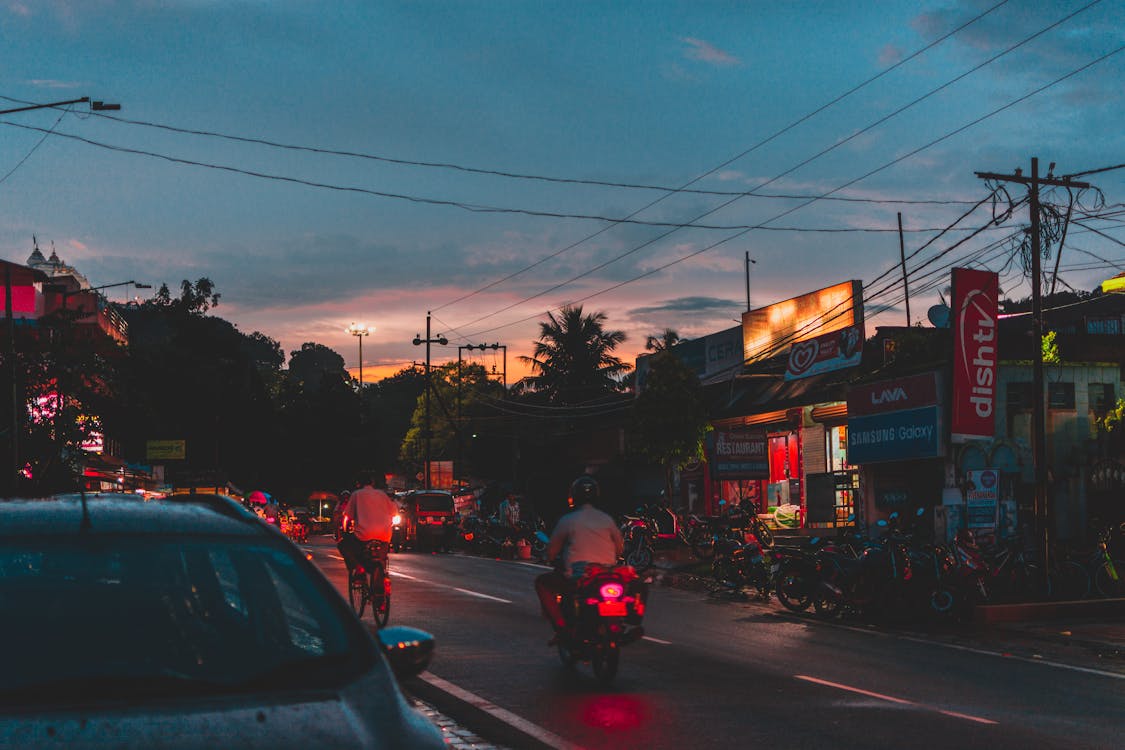As we have said before, nighttime riding can be both thrilling and dangerous. As a motorcycle operator, you need to be that much more vigilant while riding at night. In our last post, we discussed the potential obstacles you could encounter while riding in the dark and how to make yourself more visible and easily seen by other drivers. This time, we will talk about how you can be a defensive driver and take precautions to make sure you are able to see and react quickly to nighttime surprises on the road. Read on for more.

Improve Your Night Vision
Don’t Be Blinded
Oncoming headlights can be blinding, and because you are sitting a little higher than most cars, they are even more so. Looking at the farthest right line at the edge of the road on your side of the road is one possibility. This can help keep you traveling the right way and in your lane by reducing the amount of light beaming in your eyes. Do not glance down or away, since it will make it difficult for you to stay in your lane.
Ride in the Light
During the dark hours of the day, the lights on your motorcycle only extend so far in front of the bike, limiting your visibility. Your motorcycle has amazing stopping power and can stop in a short distance, but you will need additional stopping distance to avoid any obstructions up ahead. Because you can’t see miles ahead of you at night, limit your speed. It is time to take it slower if you find yourself out-riding your light.
Use the headlights of other vehicles as an extension of your own. If you are following a car ahead, keep an eye out for debris in the road, potholes, and other hazards that their headlights may reveal. Also keep in mind that cars can straddle road detritus that you can’t, putting your safety at risk. Be prepared to navigate around it or change lanes to entirely escape it, if you spot something.
Clean Your Visor
Another thing to remember about your visor is that it must be regularly cleaned. Prevent micro-scratches on your visor using a simple cleaning solution and a cotton or microfiber cloth. Micro-scratches can obscure the visor and distort vision through it over time. The visor should not be scratched with cloth towels.
Tinted Visors or Glasses for Night
Riding at night with a dark, tinted visor is not recommended, but there are some alternatives that can help. During low-light hours, such as dusk, a yellow-tinted visor or glasses can be worn. There are also photochromic visors that adjust to light levels throughout the day for individuals who do not want to worry about carrying an extra visor to swap out from day to night. You can also bring an extra pair of clear glasses to wear at night when riding with the visor down. There is no one-size-fits-all solution that will work for every rider, so try a few different things to see what works best for you.
Prepare for the Elements
Seeing Through the Fog
Fog might be more abundant during the lower evening and overnight temperatures. Fog brings condensation, which can coat your windshield, visor, and rear-view mirrors in a film of moisture. This can be inconvenient for your ride because it obstructs your vision. To prevent or reduce fogging, apply a coat of anti-fogging solution to each surface.
Temperature Variations
If you live in a location with a lot of temperature swings, you know how important it is to plan ahead. While it is simple to switch off the air conditioning and crank up the heat in a car, you do not have that luxury on a motorcycle. In hot weather, you might want to consider wearing a jacket or suit with a removable thermal liner that can be readily converted to cooler riding clothing when it gets humid. If your daily gloves are not keeping you warm enough, bring along a spare pair of gloves for night riding. Remember that riding while cold affects your ability to stay focused on the road and slows down your body’s reaction time, so be prepared.
Loss of Traction
Cooler roads give your tires less traction. Not only could cool, wet roads be a problem, but cool, dry roads might also be a problem. Be aware of your speed and proceed with caution around curves and straightaways.
Additional Safe Riding Tips
- Be a Defensive Rider: Imagining you are invisible is one of the most effective ways to keep safe. You can sometimes blend in so perfectly with the traffic that you almost become one with it. Ride defensively and always consider what you can do to keep yourself safe if another motorist fails to notice you.
- Stay Alert: You should keep your eyes on the horizon and your mirrors at all times. Place your mirrors in such a way that you can see what’s behind you without having to move your head to glance around.
- Keep Out of Blind Spots: Another person’s or a larger vehicle’s blind spot is one of the worst places to you can be. They can easily merge or change lanes into you, as well as swerve to avoid hitting road debris, resulting in an unnecessary collision.
- Use Your Signal: Turn signals are a respectful way to indicate to other drivers that you intend to change your direction by making a lane change or turning. The flashing lights can also attract the attention of another motorist while riding at night.
- Increase Driving Distance: When you can’t see clearly in front of your motorcycle, you will need to increase your following distance. While you can stop much faster than most other vehicles on the road, a lot may happen rapidly when riding at night. Adding a few seconds to your reaction time for a potential problem will far outweigh being a few minutes late due to traffic or the need to ride slower.
- Turning/ Cornering Changes: Separating the braking and turning actions is one approach to make cornering easier. Before you commit to a turn, brake the most (if not all). This gives your tires the most traction and gives you the most stability for each motion.
- Riding in Thirds: Each lane can be divided into three sections (left, center, and right), and they are all important, regardless of the time of day. To keep safe and avoid anything in the road, use them as needed. Each segment has advantages and disadvantages in terms of other drivers, debris, passing, and so on. There is no right or wrong answer when it comes to which segment you should ride in. Stay safe and visible at all times.
Riding at night can introduce you to a whole new world. You can ride the same length of road during the day for years, but a nighttime ride can entirely change your perspective. As the scenery changes, so do the threats. Small changes in your riding clothing, minor additions to your motorcycle, and adjustments to your riding behavior can help you stay safe while taking in the sights.
If you were involved in a motorcycle accident, contact the Law Offices of Kirshner, Groff, and Diaz for a no-obligation initial consultation to find out if you could be entitled to compensation. You will have the opportunity to speak about your case directly with a real attorney.

